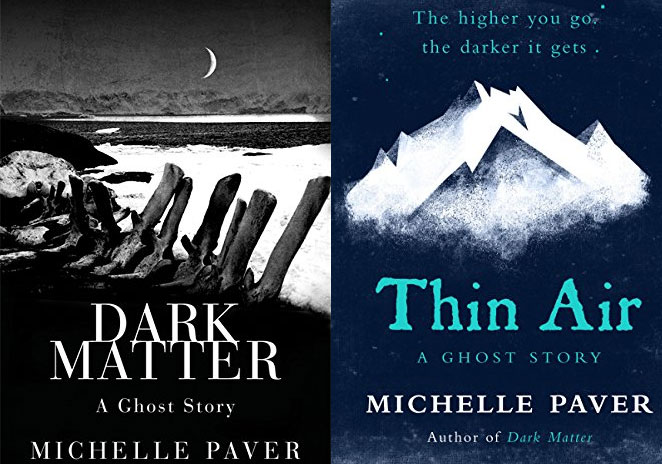On her official page, Michelle Paver is described first as simply “A Creator of Legends,” and whoever wrote that “ain’t never lied,” as the folks say. I haven’t read any of her fantasy works. I’ve only read two of her novels in fact, but they’re two of the best ghost stories I’ve ever read. This is especially remarkable as they are so similar. You might think the latter story might be less effective for being so close to the first. No, it’s still excellent, and both novels pull together something that feels like a legend. Classic, timeless lore befitting Lord Halifax’s Ghost Book.
The very high-level premise of both books–Dark Matter and Thin Air–could be described as follows: A man–an outsider among his peers–joins an expedition that will take him to one of the coldest and most inhospitable places on Earth. There, it soon becomes apparent that secrets, crimes and tragedies figuratively and literally haunt the hostile landscape, and that the unquiet dead may be willing to do something dangerous to have their story heard.
Now, if you phrase things broadly enough you can make a lot of different stories sound suspiciously similar to each other. Hell, what I wrote up above there would almost fit as a description of The Shining if you just replace a couple of words in the opening sentence. With Dark Matter and Thin Air, however, the similarities extend beyond a vague summary of each book. Certain story beats that appeared earlier in Dark Matter are replayed in Thin Air, including what happens in the climax, and this surprisingly didn’t affect my enjoyment of the latter book at all. Possibly because Paver created imagery in Thin Air that was somehow even more staggeringly haunting than what worked so well in Dark Matter.
The setting for Dark Matter is the arctic, specifically an abandoned and now dreaded mining settlement called Gruhuken, while Thin Air‘s action takes place on the Himalayan mountain Kangchenjunga. As perilous as Gruhuken proves to be, the mountain is that much more dangerous. Likewise, the revelation of what took place in Gruhuken is terrifying, while the revelation of what happened on a previous attempt to ascend Kangchenjunga managed to be even more macabre and disturbing to me. It burned an image into my brain that will live with me for as long as I have a healthy memory.
Both books are atmospheric, eerie, and patient burns leading toward impactful payoffs, and by the end both feel less like pure fiction than shadowy pieces of history. I’ll always have a soft spot for quasi-historical horror stories, possibly a product of reading Daniel Cohen’s Ghostly Terrors when I was seven or eight, a book that introduced me to Glamis Castle and its many creepy legends.
Given how much I like both of these books, I can’t really explain why I haven’t yet gotten around to Paver’s Wakenhyrst, her latest historical-spooky-fiction novel, except that even now, as I’m thinking I need to rectify that, part of me just wants to go back to Gruhuken or Kangchenjunga instead.

